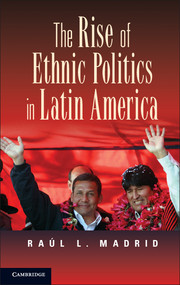Book contents
- Frontmatter
- Contents
- Figures
- Tables
- Acknowledgments
- Abbreviations
- 1 Ethnicity and Ethnopopulism in Latin America
- 2 The Ascent of the MAS in Bolivia
- 3 The Rise and Decline of Pachakutik in Ecuador
- 4 Ethnopopulism without Indigenous Parties in Peru
- 5 Indigenous Parties outside of the Central Andes
- 6 Indigenous Parties and Democracy in the Andes
- 7 Conclusion
- Bibliography
- Index
4 - Ethnopopulism without Indigenous Parties in Peru
Published online by Cambridge University Press: 05 December 2012
- Frontmatter
- Contents
- Figures
- Tables
- Acknowledgments
- Abbreviations
- 1 Ethnicity and Ethnopopulism in Latin America
- 2 The Ascent of the MAS in Bolivia
- 3 The Rise and Decline of Pachakutik in Ecuador
- 4 Ethnopopulism without Indigenous Parties in Peru
- 5 Indigenous Parties outside of the Central Andes
- 6 Indigenous Parties and Democracy in the Andes
- 7 Conclusion
- Bibliography
- Index
Summary
I am a symbol of every one of you ... we are not going to lose this opportunity for the cholos. Our turn has arrived, that is not anti-anybody, but rather pro-us.
Alejandro Toledo in a 1994 campaign speechPeru, like Bolivia and Ecuador, has some of the key ingredients necessary for the success of indigenous parties. Specifically, it has a large politically and economically marginalized indigenous population with only weak attachments to the existing political parties. This population, along with some other sectors of the electorate, has expressed considerable dissatisfaction with the traditional political parties and their economic policies in the last decade or so, and thus we might expect it to be attracted to a party that combines ethnic and populist appeals. Peru also has a long tradition of mestizaje, which has blurred ethnic boundaries and reduced ethnic polarization, thus making it feasible for an indigenous party to win support across ethnic lines.
Surprisingly, however, no major indigenous party has emerged in Peru. As we shall see, a large number of regional parties based in local indigenous or peasant organizations have competed successfully in local elections. None of these parties has been able to translate their local successes to the national level, however.
- Type
- Chapter
- Information
- The Rise of Ethnic Politics in Latin America , pp. 108 - 145Publisher: Cambridge University PressPrint publication year: 2012

